Ken Neill
published in Angler
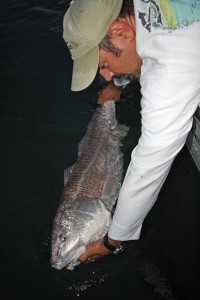 It happens each spring. We know better but it just does not matter. Big red drum arrive and we become “drum dumb”. Big reds arrive in our coastal waters each April. This early drum bite is primarily in the surf on the seaside of Virginia’s Eastern Shore. This surf bite remains strong through the month of May. It is an excellent fishery for surfcasters fishing from the beaches.
It happens each spring. We know better but it just does not matter. Big red drum arrive and we become “drum dumb”. Big reds arrive in our coastal waters each April. This early drum bite is primarily in the surf on the seaside of Virginia’s Eastern Shore. This surf bite remains strong through the month of May. It is an excellent fishery for surfcasters fishing from the beaches.
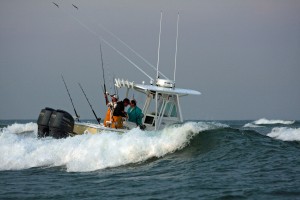 We will be in there surf fishing from our boats. Shallow bars and breaking waves are not a great place for a boat to be. We will not be alone though. Boats of various shapes and sizes will be in there being drum dumb. There will even be kayaks and jet skis playing in the surf.
We will be in there surf fishing from our boats. Shallow bars and breaking waves are not a great place for a boat to be. We will not be alone though. Boats of various shapes and sizes will be in there being drum dumb. There will even be kayaks and jet skis playing in the surf.
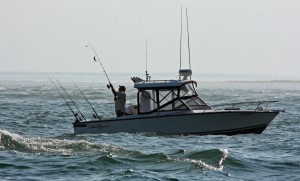 The fishing is fantastic but first some words of caution. You can get in trouble pretty fast in that shallow water. If you insist on being drum dumb, go with somebody that is experienced in fishing the inlets and in and around the bars on the seaside of the Eastern Shore. If you are going to explore this fishery in your own boat, go during the daytime. Low tide is best so that you can see where the bars and the deeper water channels are and when you do find bottom, you will have an incoming tide to help you out.
The fishing is fantastic but first some words of caution. You can get in trouble pretty fast in that shallow water. If you insist on being drum dumb, go with somebody that is experienced in fishing the inlets and in and around the bars on the seaside of the Eastern Shore. If you are going to explore this fishery in your own boat, go during the daytime. Low tide is best so that you can see where the bars and the deeper water channels are and when you do find bottom, you will have an incoming tide to help you out.
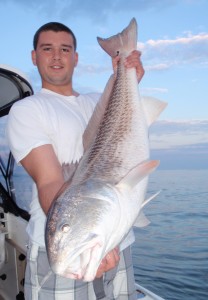 At the beginning of a new season, a daytime scouting trip is a good idea for even the most experience fishermen. We will have the channels, bars, and best fishing locations on our chart plotters from the previous spring. The bars and channels will not be where we left them last year (or even last week if there has been a blow).
At the beginning of a new season, a daytime scouting trip is a good idea for even the most experience fishermen. We will have the channels, bars, and best fishing locations on our chart plotters from the previous spring. The bars and channels will not be where we left them last year (or even last week if there has been a blow).
Red drum feed during the daytime and nighttime. We fish for them all day and night. A lack of sleep is another part of being drum dumb. Sleeping is something that you do after the spring drum season is over. In general, the nighttime bite will be best. Often, we will get set up in the afternoon, fish all night on into the morning hours and come on in for a noon siesta.
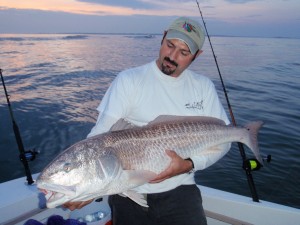 Drum dumb means fishing when it is too rough. You will catch them in beautiful slick calm conditions but some white water really seems to turn these fish on. It is a fine line between great drum fishing conditions and being too rough to be out there. Too often, we cross that line. Try not to be too drum dumb. A light wind with waves breaking on the bars is a great combination. Anchor close enough to the breakers that you can cast to them and keep your boat in the deeper, calmer waters. Pay attention at all times. As the tide and wind shifts, you will have to reposition your boat or you may just find that you are now in the breakers rather than casting to them.
Drum dumb means fishing when it is too rough. You will catch them in beautiful slick calm conditions but some white water really seems to turn these fish on. It is a fine line between great drum fishing conditions and being too rough to be out there. Too often, we cross that line. Try not to be too drum dumb. A light wind with waves breaking on the bars is a great combination. Anchor close enough to the breakers that you can cast to them and keep your boat in the deeper, calmer waters. Pay attention at all times. As the tide and wind shifts, you will have to reposition your boat or you may just find that you are now in the breakers rather than casting to them.
 Tackle consists of 20-30 pound-class spinning and bait-casting rod and reels. A fish-finder rig is typically used with a pyramid sinker heavy enough to keep your baits where you want them. Leaders of about 60-pound monofilament are kept short to aid in casting. Both circle and j-hooks are effective with about 9/0 being the average size. Cast your baits towards the white water and wait for your rod to bend over and your drag to start screaming.
Tackle consists of 20-30 pound-class spinning and bait-casting rod and reels. A fish-finder rig is typically used with a pyramid sinker heavy enough to keep your baits where you want them. Leaders of about 60-pound monofilament are kept short to aid in casting. Both circle and j-hooks are effective with about 9/0 being the average size. Cast your baits towards the white water and wait for your rod to bend over and your drag to start screaming.
 Baits consist of fish and crab. Fresh, cut bunker works great. Peeler crab is a red drum favorite. Live croaker and spot are good baits. The abundant populations of sharks, rays and skates love all of that stuff as well as the red drum do. If the by-catch is driving you crazy, using whole, live hard crab will cut down on that problem. Big red drum have no problem crunching down a crab.
Baits consist of fish and crab. Fresh, cut bunker works great. Peeler crab is a red drum favorite. Live croaker and spot are good baits. The abundant populations of sharks, rays and skates love all of that stuff as well as the red drum do. If the by-catch is driving you crazy, using whole, live hard crab will cut down on that problem. Big red drum have no problem crunching down a crab.
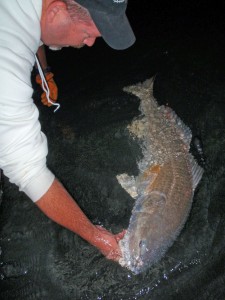 The location we are fishing during the early drum run is primarily the surf zone of Fisherman’s and Smith Islands and inside the inlet between the two islands. That area is a good early spot and it is close to us. We have fished on up to the Hog Island area and the inlets along the way and all can be great drum areas. While the beaches and inlets of the Eastern Shore are great for an early red drum bite, you have other options if you do not want to put your boat in the surf zone (meaning that you are smarter than the people I hang out with).
The location we are fishing during the early drum run is primarily the surf zone of Fisherman’s and Smith Islands and inside the inlet between the two islands. That area is a good early spot and it is close to us. We have fished on up to the Hog Island area and the inlets along the way and all can be great drum areas. While the beaches and inlets of the Eastern Shore are great for an early red drum bite, you have other options if you do not want to put your boat in the surf zone (meaning that you are smarter than the people I hang out with).
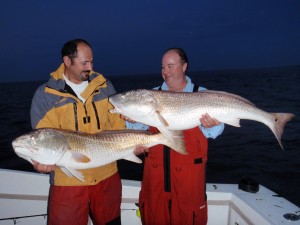 The various shoals near the mouth of the Chesapeake Bay are excellent locations to anchor on and soak baits for big springtime red drum. Nautilus, Latimer and Nine Foot Shoals are all productive red drum locations. The area near buoys 8 and 10, towards Fisherman’s Island, on the seaside of the CBBT, is another great drum spot. You still need to watch the sea conditions as you can still get some pretty impressive waves on these shoals at times. But in general, it will be calmer and you are not going to beach your boat. This “shoal” fishery will be very productive during the months of May and June with the full moons of these months being prime.
The various shoals near the mouth of the Chesapeake Bay are excellent locations to anchor on and soak baits for big springtime red drum. Nautilus, Latimer and Nine Foot Shoals are all productive red drum locations. The area near buoys 8 and 10, towards Fisherman’s Island, on the seaside of the CBBT, is another great drum spot. You still need to watch the sea conditions as you can still get some pretty impressive waves on these shoals at times. But in general, it will be calmer and you are not going to beach your boat. This “shoal” fishery will be very productive during the months of May and June with the full moons of these months being prime.
